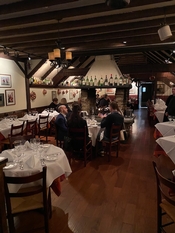
Rather than be seated in the main restaurant area, we enjoyed a private space near the entrance. The service was as excellent as the food, which reminded me of fine bistro fare. And quite authentic. Clients could order for example the ris de veau (sauteed veal sweetbreads), which is not always listed in French restaurants in the US. How about tripes? I am not a fan, but for tripe lovers, they come with carrots braised in Calvados. Other meaty options include the Boudin Blanc – a house chicken and pork sausage in Madeira sauce with caramelized apples. Sounds nice for a cold winter evening. Some of our party opted for the venison medallions which looked good. For my part, thinking of great Pauillac wine, the choice fell between duck breast and steak au poivre, and I opted for the latter, as it was a seared center cut aged New York strip steak in a savory peppercorn sauce.
Hungry? Well, there is so much more, including excellent charcuterie starters, roasted red beets, and the starter I chose: escargots soaked in garlic and parsley. Not ideal for Mouton, I enjoyed them before, over quality Champagnes. Lovers of fish and seafood find plenty of happiness here, as well, with dishes ranging from grilled center cut Atlantic swordfish and sauteed sea scallops to fresh boned rainbow trout. It is more challenging for vegetarians, but try the aforementioned roasted red beets with herbed Vermont goat cheese or an excellent winter salad with arugula, baby red oak, dried cranberries, red onions and pistachio nuts among other appealing ingredients.
Champagnes:
As to the wines, we had two corked bottles: the Philipponnat Clos de Goisses 1996 and the Mouton Rothschild 1986. Two great wines in great vintages, alas! But no worries, as many shined bright. Let’s start with a somewhat underrated Champagne that brings you more bang for your buck, albeit Champagne prices make our bucks less powerful in most cases anyway.
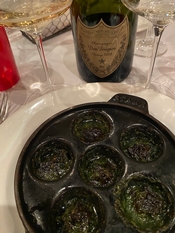
We then tried an excellent Dom Perignon 2008, which has become already a legendary vintage, and with legendary pricing – even if prices have become even more legendary since the 2012 vintage. Who knows how much is produced? Certainly, LVMH won’t reveal the secret, so bottle variation happens. This happened to be a good bottle, even if some noted a bit of funk in the nose, but the palate was gorgeous with vivid expressions of toast and brioche and lime/lemon freshness delivered in a smooth, almost caressing texture. The bubbles? Very fine!
The Philipponnat Clos de Goisses 2012 was opened too cold (I brought it from a very cold cellar), but once in glass for a while, what sheer opulence and vinosity! Clearly the most “vinous” among the Champagnes we enjoyed, from an exemplary vintage, as owner Charles Philipponnat advised me to buy it rather than the 2011, which I had tasted while visiting his estate. An Extra Brut, albeit with just under 5 grams per liter dosage, the bright acidity balances the opulence, with notes ranging from kirsch to honey, from white flower to lemon and grapefruit. The blend is typically two-thirds Pinot Noir and the rest Chardonnay. Long finish.
Dry Whites:
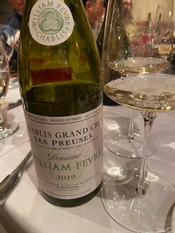
We then enjoyed three dry whites, two from Burgundy and the other from the northern Rhône. My overall favorite was the William Fèvre Grand Cru Les Preuses Chablis 2010, which seemed at first rather reductive in aspect, but time in glass yielded stony, flinty charm coupled with green apple and white flower bouquet aromas. The palate was not as sumptuous as the other two wines, but the most precise and frankly the most interesting to me… but of course it comes down to pairing. I immediately thought of quality raw oysters as a classic marriage, but this would also grace lobster.
Yet another impressive wine was the Olivier Leflaive Batard Montrachet Grand Cru. I loved my visit back in 2005 to Domaine Olivier Leflaive for a rousing lunch of education and fine food: starting with the humblest appellations and ending with a grand vin like this one. While not as impressive as Anne Leflaive, Olivier Leflaive makes darn good wines, and here the 2011 proved its mettle with butterscotch opulence and palate filling body. Then came the 2014 vintage of Domaine Georges Vernay Condrieu Les Chaillées de l’Enfer (the pits of hell?), which was anything but hellish. The Viognier grape shines in this northern Rhône appellation, but here we have a wine that is quite rich in expression, but with the acidity of the vintage. The 25% new oak barrels with regular stirring of lees lends a specific opulence as well to this wine, which is very spicy, floral and stone fruit driven, conveying both viscosity and balancing acidity.
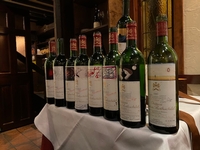
We then arrived to the point of the evening, the Moutons. Overall, my favorites proved a tie between the 1996 and the 2009. Likely to match both is the 2019, which is quite gorgeous, and deceptively soft. It has much tannin, but of such a silky nature that it could end up like a modern-day 1982.
2019 – We began young to old, with what proved to be a rather controversial wine for the evening. I had recently tasted the 2020 from bottle at the estate, and it showed more tannic power. Indeed, the Mouton director says that the 2020 has "greater depth." While many – including myself – have waxed fantastic over the 2019 vintage, including Mouton, this evening left some of us perplexed given the wine’s very soft expression. I rather liked the wine for its pencil lead notes, delivered in a palate creamy and vinous, with 100% new oak aging very well integrated. I had tasted the 2019 Pichon Longueville the week before, which tasted more obviously like a barrel sample, with some lingering oak notes. "Just amazing," I wrote in my notes. But the Comtesse did seem to have a bit more energy to it. Indeed, one critique raised over the Mouton was its modern aspect, and, to be sure, one does not get a sense immediately of Pauillac power, as one does more in a vintage like 2009 for Mouton (see below), also marked by the sun.
Another critique was how the wine “might lack a bit of energy” despite it being “quite delicious, soft and dense.” Many critics have given very high scores to the wine, despite some of our reactions, to the point where one participant talked of having an inherent "First Growth bias." Indeed, it would be very useful to more often have blind tastings of the Firsts along with the Super Seconds each vintage. I have noticed in some vintages how certain Super Seconds can rival and surpass some First Growths. It would be great (if expensive) to more often hold blind tastings comparing the Firsts with other strong brands such as the two Pichons in Pauillac, Palmer in Margaux, the Léovilles in Saint Julien.
But for the Mouton 2019, I would err on the side of hope. I do not mind the wine’s softness as (hopefully) reflecting satiny tannins that are soft in expression, sure, but the wine’s density should pack underlying power. It is great how the wine has absorbed the 100% new oak. And it is, after all, far too young to truly appreciate (certainly no tertiary complexity yet), but then again already rather sexy. I should have bought this for the relatively modest release price, also because the label, “Solar Iris” by Olafur Eliasson, is so cool. As for points? I was enthusiastic with 98, but will amend to 96+ or 97 given the doubts. Let’s try it again in 2032!
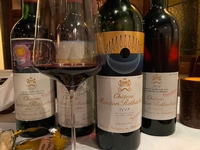
2009 – I had an epiphany when I first tried this from bottle three years ago with former Mouton director Philippe Dhalluin, who had poured it blind to me over lunch. What impresses most? It is at once welcoming and ripe, and powerful and tannic (in a very good way). For some reason, I had guessed 2010, when Dhalluin asked me about it. I think he just opened it because he liked it so much as a vintage, but it proved the point that 2009s can be underestimated compared with 2010s. A noted Bordeaux expert who shuns the limelight, Nicolas Vivas, told me at the time how “perfect” the weather conditions were for the 2009 vintage: “Better than 2005,” he stressed. Indeed, the conditions encouraged concentration of aromas and anthocyans, and that is proven in bottle 10 years later. Sure, in some cases the 2010s are clearly better, with more structure and staying power. In many cases, 2010 is a unicorn vintage. But with Mouton, the 2009 is nearly perfect. 99
2002 – Coming from a terrible August, I recall being in Bordeaux that month in 2002: raining cats and dogs. But an Indian Summer helped to ripen the Cabernets especially, and so some people underestimated the 2002 vintage, especially for the Left Bank. However, in some cases, I am beginning to wonder how long these will last. Over dinner in Georgetown, we served the 2009 and 2002 side-by-side, which is unfair to the 2002. Very different, it is cooler and more attenuated by comparison, but there is linearity and refinement to the tannin. I recall absolutely loving this wine some 10 years ago, and a very good friend of mine in Alsace had paired it with pizza, also loving it. I do not think it will gain any more charm, although the tertiary notes will increase over the next two decades. But it will remain a leaner style of Mouton. 93
1998 – A vintage billed as better for the Right Bank and the Graves, and easy to understand given the climate and weather over the summer and into the harvest: the growth cycle enjoyed ideal conditions up until rain in September and October disturbed the harvest. But some star estates in the Médoc don’t get the love they deserve. Having said this, Haut Brion and La Mission Haut Brion are superior wines in 1998. The Mouton exudes distinct mocha and wet stone aromas, with telltale black current and blackberry. I love the palate opulence and underlying tannic power from this blend of 86% Cabernet Sauvignon, 12% Merlot and 2% Cabernet Franc. And the finish leaves you with pleasing notions of roasted fruit and creosote. But, compared to the laser focused 1996, tasted next, this wine seems somewhat aimless and dispersed. A terrific label by artist Rufino Tamayo. 95+
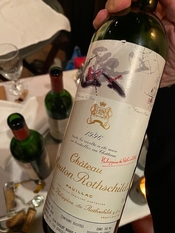
1996 – Along with the 2009, my Mouton of the evening. And what is not to love from this blend of 77% Cabernet Sauvignon, 13% Merlot and 10% Cabernet Franc? Lead pencil, graphite, cigar box, and other synonyms but boy oh boy do they enchant you in spades. Approaching a quarter-century mark, the wine still conveys primary fruit, including subtle cherry and blueberry notes. Some time ago, I recall a famous critic proclaiming that 2002 is a better version of 1996. Hogwash. 1996 is the real deal. Indeed, the estate describes the climactic conditions as “almost ideal” – especially for Cabernet Sauvignon. A cool May delayed flowering for one week, but warm and sunny weather in June ensured even flowering, followed by hot and dry weather in July and August. In 2002, August was ugly. Anyway, this wine shows off such length and such elegance, communicating impressive breed and racy excitement – and a very long finish. 100 points for lovers of classicism, maybe 98 for people who want more bombast. 99
1995 – Aromatically appealing with notes of creosote, blackberry, tobacco leaf and hints of truffle. The tannins are powerful and somewhat uneven from this blend of 72% Cabernet Sauvignon, 19% Merlot and 9% Cabernet Franc, when compared with the 1996, which has a smoother texture. And yet the power and intensity only increase (and impresses) with time in glass. Readers may recall how Merlots excelled in this vintage, along the lines of the 1998, with optimal August ripening, following a torrid month of July. Rain in early September raised warning flags but the 12-27 September harvest occurred under more clement skies. The 1995 needs more time for further tannin integration, but I doubt that it will ever reach the heights of the 1996. 96
1988 – I have had mixed experiences with this vintage from Mouton but tonight it was a strong showing of refined Cuban cigar, smoothly textured – I wrote the word “svelte” when assessing the tannins. Along with some roasted plum and cassis aspects, the cooler finish left an impression of both lavender and mint. A lovely wine, blending 75% Cabernet Sauvignon, 13% Merlot, 10% Cabernet Franc and 2% Petit Verdot. Too much rainfall in the Spring and too little in summer disrupted the growing cycle and vines suffered from an unbalanced water supply, but showers in early September followed by hot weather allowed for ripeness later that month, with a long harvest stretching from September 28 to October 14. I have always loved the Keith Haring art on the label. 96
1986 – Corked, sadly.
1983 – Smooth and fun to drink, if not the most intense or deep, this blend of 75% Cabernet Sauvignon, 15% Merlot, 8% Cabernet Franc and the rest Petit Verdot has always been in the shade of the amazing 1982 vintage. While not the showstopper its elder sibling is, the 1983 conveys much charm, imbued in light notes of espresso, tobacco and incense. I appreciate the existing tannic structure, indicating that the wine is still on its plateau of drinkability 40 years on, but this Mouton is clearly more tertiary than primary, even if you get a pleasing sense of red and blackberry fruit. The climate conditions resemble the 1988 vintage. Interesting to note heavy rains in April and the wettest May since 1962, with dry weather in June and a torrid July and August albeit with storms that brought more rain. An anticyclone yielded a fine Indian Summer that benefited the Cabernets, as the harvest took place between 3-11 October. 95
As we approached the end of the evening, we enjoyed two Yquems, and the 2003 proved especially stunning. Château d’Yquem is justifiably recognized as the  best late harvest “sweet” wine in the world, or at least among the top five. And the 2003 vintage from half bottle yielded such incredible intensity of aromas and flavors ranging from chestnut liqueur, toffee, peach and orange rind. The botrytis-developed note of black tea was unmistakable, as was a gorgeous (and quite fresh for the vintage) finish marked by nutmeg, so enjoy over Christmas 2023. The Château d’Yquem 2005 also impressed although not as much: very opulent and full bodied, it was just not quite as focused and as spicy as the 2003.
best late harvest “sweet” wine in the world, or at least among the top five. And the 2003 vintage from half bottle yielded such incredible intensity of aromas and flavors ranging from chestnut liqueur, toffee, peach and orange rind. The botrytis-developed note of black tea was unmistakable, as was a gorgeous (and quite fresh for the vintage) finish marked by nutmeg, so enjoy over Christmas 2023. The Château d’Yquem 2005 also impressed although not as much: very opulent and full bodied, it was just not quite as focused and as spicy as the 2003.
Thanks to all who shared such exceptional wines, and it was great seeing each other in a lovely setting as part of the new year festive feeling.
